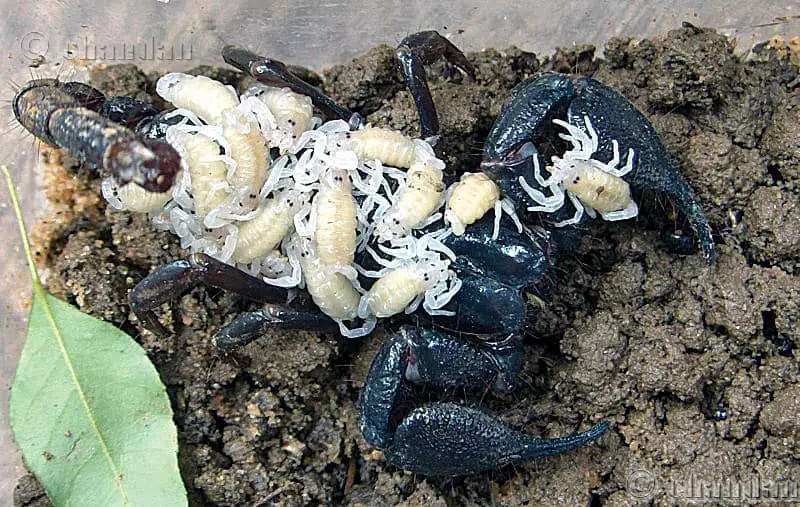Want to breed your emperor scorpions, but don’t know how? You are at the right place. In this article, I will guide you on how to breed Pandinus imperator, the emperor scorpion.
To breed emperor scorpions, introduce the male scorpion into the female enclosure and let them mate. Remove the male once mating is completed. Gravid emperor scorpions lay 12-24 babies in 8 to 12 months. Feed the brood with crickets and house them individually once the juveniles are able to hunt by themselves.
Breeding of emperor scorpions is relatively easy because the mother scorpion takes care of her brood and the amount of litters is considered small in the arthropods world. Having said that, there are difficulties involved, especially in the preparation parts. Make sure you read my guide on how to keep emperor scorpions if you have not, before proceeding to breed your scorpions.
How to Sex Emperor Scorpions
Obviously you need both male and female scorpions to breed. However, it is quite challenging to distinguish between male and female scorpions!
The easiest way sex scorpions is to look at the pecten, a comb-like structure on the underside of a scorpion. Male scorpions have longer pectines with more teeth than the females.
To view the pectines, simply put the scorpion into a small transparent container and observe the underside of the scorpion. Note that sexing through observation of pectines is a relative comparison. It’s easier if you have specimens of similar sizes to tell the difference.
Another characteristic of a matured female emperor scorpion is the pointy genital opercula that resemble a heart shape. The genital opercula are located just before the pectines.
You can refer to the post here which shows you clear pictures of pectines and opercula in male versus female emperor scorpions.
Other secondary characteristics that separate male from female emperor scorpions are overall sizes, pedipalps and the pincers. Male scorpion is smaller in size. However they have bigger pedipalps (the feelers near their mouthparts) and bigger granulation on their pincers. Again those are non- definitive comparisons, but can serve as guidance.
Maturity of the Scorpions
On top of knowing the sex of your scorpions accurately, you need to know whether your scorpions are sexually mature. Unfortunately, there’s no easy way to know that.
Emperor scorpions molt 6 times to turn into adults. The life stage before the 1st molt is called the 1st instar. The 1st instar molts into the 2nd instar and so on. The 5th instar, which is the stage before the 6th molt, is known as the sub-adult by hobbyists. Sub-adults resemble adults, except they are not sexually mature.
When you buy your scorpions, always confirm the instar of the scorpions with the seller. Then, record and count each molt so that you know for sure when it reaches adulthood. Unless you have a lot of experience handling emperor scorpions, that’s the only reliable way to know whether your scorpions are adults.
Another supporting (again not definitive) clue that you can refer to is the size. Adult emperor scorpion can reach up to 8 inches from head to tail. If your scorpion is only 5 inches long, most likely it is not an adult.
It takes about 3 years for a newborn emperor scorpion to reach adulthood. 2-3 weeks after your scorpions molt into adults, they should be ready to mate.
Preparation for Mating
If you keep your female scorpion in a small container, you need to move her into a larger container that can house 2 scorpions. The set up of this new container should be the same as how you would normally set up the container for your emperor scorpion. If you do re-house her, please give her another week or 2 to acclimate to the new environment.
Feed your scorpions with 3-4 crickets a few days before you want them to mate.
Promenade á Deux – Let the Waltz Begin!
Scorpion mating is best performed late in the evening. Dim the light to create a “romantic” environment for your scorpions. If it’s too dark for you to handle the mating, turn on the red light.
When you are ready, introduce the male scorpion into the female housing, as far from the female as possible. The male scorpion will start juddering and approach the female once he senses her presence.
If the female is receptive, you will see both scorpions holding the pincers of each other and “dancing”. That’s known as the promenade á deux.
The male scorpion may sting the female to calm her down. Don’t be alarmed if you see that. The female scorpion may try to attack the male as well. Interfere with a pair of tweezers if you think he could be harmed.
During the dance, the male scorpion will look for a suitable spot on the ground to deposit his spermatophore, a stick-like structure containing the sperms. The whole mating process can last for 5 minutes to an hour, depending on how fast the male scorpion locates the suitable spot to deposit his spermatophore.
After depositing the spermatophore, the male scorpion will guide the female to move above the spermatophore so that it is directly below her opercula. Then, the female scorpion will “sit” onto the spermatophore to pick up the sperm.
Once mating is done, the male scorpion will disengage the female. When you see this, immediately remove him. Sometimes, the female scorpion may attack and consume the male after mating. So, better be safe than sorry.
Let the couple rest for 2 weeks and then mate again if you are not sure whether the female scorpion has been impregnated. If she refuses to mate on the 2nd attempt, she is likely gravid or pregnant.
If the female is not receptive in the first place, separate them and try again in the next evening. Do remember that only adults of opposite sex will mate!
Maternity Care for Your Scorpion
The opisthosoma (tummy) of a gravid female will gradually become bloated as her babies grow in her tummy. Feed her with more food than you usually would.
Gravid emperor scorpion prefers a slightly warmer temperature and higher humidity than usual. You will see her spending more time closer to where the heat mat and water dish are placed. Make sure the heat mat is always on and the water dish is always filled.
It takes 8 to 12 months for the embryos to develop before the emperor scorpion gives birth to her babies. A week or 2 before giving birth, the mother scorpion will stop eating. You might even see her killing crickets but not feeding them, presumably to remove all possible threats that may harm her during the delivery.
When you observe that, stop giving her crickets and leave her alone. The scorpion will soon burrow and hide in her cave until she delivers her babies.
Caring for the Brood

Emperor scorpions give birth to 12-24 babies per litter. The mother scorpion carries her baby on her back. Each baby is about 1 inch in length and appears whitish. Newborns don’t eat anything until after their first molt.
Feed the brood with crickets twice a week. At this stage, it is important to provide enough food to the brood to minimize cannibalism. Try to use smaller crickets if you can, but it is not a must. The mother scorpion will do the hunting and tear the food apart to feed her brood. The baby scorpions are still too young to hunt at this stage.
Continue to keep the enclosure moist, warm, and ventilated.
As the scorpions grow, they slowly attempt to hunt by themselves. Once the juvenile scorpions are able to hunt by themselves, it is time to split them into individual containers. Do note that you can continue to keep them in the same container if you want, but be warned on some levels of cannibalism.
Recommended Supplies
Here are some supplies that you can buy for your emperor scorpions breeding project. Note that I get a small commission when you buy the items through the links in this page. This helps me to maintain the site without incurring additional costs to you.
Last Words
More and more hobbyists have started breeding their own emperor scorpion since the species was listed in CITES Appendix 2 many years back. This helps greatly not only in preserving the species but also allows us to understand more about the biology of scorpions.
Compared to other arthropods, scorpion breeding is still at its early stage. Hobbyists are still exploring how to breed specimens as big as or bigger than wild-caught specimens. If you wish to contribute, record and share your results and observations in forums. That will help others to improve and one day we will understand scorpions as much as we understand cats and dogs.



